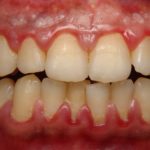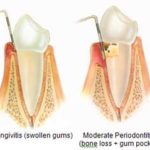Gum Disease is also known as periodontal disease and is an infection of the gum tissue around the tooth. This infection is a result of plaque being left on the tooth that hardens to become tartar and calculus. This hard buildup has to be professionally removed. If left, it irritates the gums to cause inflammation and this inflammation irritates the underlying bone. When bone is irritated, it dies and thus results in bone loss and pocketing around the teeth.
Home oral hygiene is also of utmost importance since we want to do everything possible to keep the amount of bad bacterial to a minimum. Bacteria eats plaque so all the plaque must be removed to keep these harmful bacteria at bay.
If you think of the gum “pocket” like a turtleneck sweater, there is a cuff that sits around the tooth. A normal, healthy gum pocket is 1-3mm and measured during our annual full mouth gum charting. Pockets in mouths with periodontitis can range anywhere from 4-12+mm. Patients can keep a 4mm pocket clean with excellent oral hygiene and a hygienist can help to keep 5-6mm pockets clean with regular cleanings. Deeper than 7mm requires a visit to the Periodontist (gum and bone specialist) where further gum surgery may be needed to help lessen the pocket.
Once a patient is diagnosed with gum or periodontal disease, a deep scaling is needed and usually involves numbing the area so we can accurately clean the entire pocket, thus eliminating gum irritation. Patients who have or had periodontal disease also have a different type of more harmful bacteria in their mouth and are more susceptible to having the disease reoccur. As a result, we recommend more frequent cleanings (called periodontal maintenance cleanings) of 3-4 months to ensure plaque and tartar is swiftly and completely removed.
Don’t let all of this information scare you either. Most people self-diagnose themselves with gingivitis or isolated gum inflammation as a result of seeing red or blood in their saliva after brushing. If you see red, this means you need to brush that area better to remove the plaque and bacteria that is causing the bleeding. Many of our patients think they will avoid the area to let it heal, but our recommendation is the opposite. Gently brush the area to induce bleeding and this will help to wash out the harmful bacteria as well. With proper technique, the area of bleeding should resolve itself in 5-7 days. If it does not, call the office for an evaluation.








